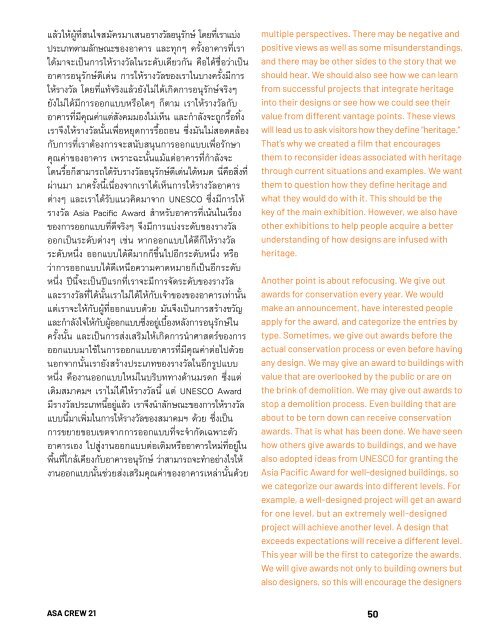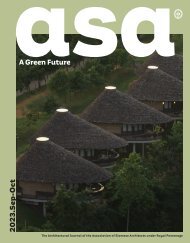ASA CREW VOL. 21
ASA CREW VOL. 21 ว่าด้วยสถาปัตยกรรมอันเป็นหลักฐานด้านวัฒนธรรมของชาติ เป็นที่บันทึกเรื่องราวมากมาย เช่น ความเชื่อ การใช้ชีวิต ความเจริญด้านเศรษฐกิจและด้านเทคโนโลยีของกลุ่มคน ในอดีตที่ถูกถ่ายทอดออกมาข้ามกาลเวลา
ASA CREW VOL. 21 ว่าด้วยสถาปัตยกรรมอันเป็นหลักฐานด้านวัฒนธรรมของชาติ เป็นที่บันทึกเรื่องราวมากมาย เช่น ความเชื่อ การใช้ชีวิต ความเจริญด้านเศรษฐกิจและด้านเทคโนโลยีของกลุ่มคน ในอดีตที่ถูกถ่ายทอดออกมาข้ามกาลเวลา
Create successful ePaper yourself
Turn your PDF publications into a flip-book with our unique Google optimized e-Paper software.
แล้วให้ผู้ที่สนใจสมัครมาเสนอรางวัลอนุรักษ์ โดยที่เราแบ่ง<br />
ประเภทตามลักษณะของอาคาร และทุกๆ ครั้งอาคารที่เรา<br />
ได้มาจะเป็นการให้รางวัลในระดับเดียวกัน คือได้ชื่อว่าเป็น<br />
อาคารอนุรักษ์ดีเด่น การให้รางวัลของเราในบางครั้งมีการ<br />
ให้รางวัล โดยที่แท้จริงแล้วยังไม่ได้เกิดการอนุรักษ์จริงๆ<br />
ยังไม่ได้มีการออกแบบหรือใดๆ ก็ตาม เราให้รางวัลกับ<br />
อาคารที่มีคุณค่าแต่สังคมมองไม่เห็น และกําลังจะถูกรื้อทิ้ง<br />
เราจึงให้รางวัลนั้นเพื่อหยุดการรื้อถอน ซึ่งมันไม่สอดคล้อง<br />
กับการที่เราต้องการจะสนับสนุนการออกแบบเพื่อรักษา<br />
คุณค่าของอาคาร เพราะฉะนั้นแม้แต่อาคารที่กําลังจะ<br />
โดนรื้อก็สามารถได้รับรางวัลอนุรักษ์ดีเด่นได้หมด นี่คือสิ่งที่<br />
ผ่านมา มาครั้งนี้เนื่องจากเราได้เห็นการให้รางวัลอาคาร<br />
ต่างๆ และเราได้รับแนวคิดมาจาก UNESCO ซึ่งมีการให้<br />
รางวัล Asia Pacific Award สําหรับอาคารที่เน้นในเรื่อง<br />
ของการออกแบบที่ดีจริงๆ จึงมีการแบ่งระดับของรางวัล<br />
ออกเป็นระดับต่างๆ เช่น หากออกแบบได้ดีก็ให้รางวัล<br />
ระดับหนึ่ง ออกแบบได้ดีมากก็ขึ้นไปอีกระดับหนึ่ง หรือ<br />
ว่าการออกแบบได้ดีเหนือความคาดหมายก็เป็นอีกระดับ<br />
หนึ่ง ปีนี้จะเป็นปีแรกที่เราจะมีการจัดระดับของรางวัล<br />
และรางวัลที่ได้นั้นเราไม่ได้ให้กับเจ้าของของอาคารเท่านั้น<br />
แต่เราจะให้กับผู้ที่ออกแบบด้วย มันจึงเป็นการสร้างขวัญ<br />
และกําลังใจให้กับผู้ออกแบบซึ่งอยู่เบื้องหลังการอนุรักษ์ใน<br />
ครั้งนั้น และเป็นการส่งเสริมให้เกิดการนําศาสตร์ของการ<br />
ออกแบบมาใช้ในการออกแบบอาคารที่มีคุณค่าต่อไปด้วย<br />
นอกจากนั้นเรายังสร้างประเภทของรางวัลในอีกรูปแบบ<br />
หนึ่ง คืองานออกแบบใหม่ในบริบททางด้านมรดก ซึ่งแต่<br />
เดิมสมาคมฯ เราไม่ได้ให้รางวัลนี้ แต่ UNESCO Award<br />
มีรางวัลประเภทนี้อยู่แล้วเราจึงนําลักษณะของการให้รางวัล<br />
แบบนี้มาเพิ่มในการให้รางวัลของสมาคมฯ ด้วย ซึ่งเป็น<br />
การขยายขอบเขตจากการออกแบบที่จะจํากัดเฉพาะตัว<br />
อาคารเอง ไปสู่งานออกแบบต่อเติมหรืออาคารใหม่ที่อยู ่ใน<br />
พื้นที่ใกล้เคียงกับอาคารอนุรักษ์ว่าสามารถจะทําอย่างไรให้<br />
งานออกแบบนั้นช่วยส่งเสริมคุณค่าของอาคารเหล่านั้นด้วย<br />
multiple perspectives. There may be negative and<br />
positive views as well as some misunderstandings,<br />
and there may be other sides to the story that we<br />
should hear. We should also see how we can learn<br />
from successful projects that integrate heritage<br />
into their designs or see how we could see their<br />
value from different vantage points. These views<br />
will lead us to ask visitors how they define “heritage.”<br />
That’s why we created a film that encourages<br />
them to reconsider ideas associated with heritage<br />
through current situations and examples. We want<br />
them to question how they define heritage and<br />
what they would do with it. This should be the<br />
key of the main exhibition. However, we also have<br />
other exhibitions to help people acquire a better<br />
understanding of how designs are infused with<br />
heritage.<br />
Another point is about refocusing. We give out<br />
awards for conservation every year. We would<br />
make an announcement, have interested people<br />
apply for the award, and categorize the entries by<br />
type. Sometimes, we give out awards before the<br />
actual conservation process or even before having<br />
any design. We may give an award to buildings with<br />
value that are overlooked by the public or are on<br />
the brink of demolition. We may give out awards to<br />
stop a demolition process. Even building that are<br />
about to be torn down can receive conservation<br />
awards. That is what has been done. We have seen<br />
how others give awards to buildings, and we have<br />
also adopted ideas from UNESCO for granting the<br />
Asia Pacific Award for well-designed buildings, so<br />
we categorize our awards into different levels. For<br />
example, a well-designed project will get an award<br />
for one level, but an extremely well-designed<br />
project will achieve another level. A design that<br />
exceeds expectations will receive a different level.<br />
This year will be the first to categorize the awards.<br />
We will give awards not only to building owners but<br />
also designers, so this will encourage the designers<br />
_ผู้จัดงานมีความคาดหวังจากตัวสถาปนิกหรือจากคน<br />
ภายนอกที่เข้ามาดูงานอย่างไร<br />
มันก็คงตรงกับชื่องานเลยครับ เราคาดหวังว่าเขาจะได้มา<br />
พบกับมุมมองใหม่ แล้วก็คิดว่าจะสามารถเปลี่ยนความคิด<br />
ที่มีจากเดิมที่คิดว่ามรดกเป็นเรื่องที่ไกลตัว พอเขารับรู้ได้<br />
ว่ามันเป็นเรื่องที่ใกล้ตัวการที่เขาจะนํามรดกมาใช้ให้เป็น<br />
ประโยชน์มันย่อมเกิดขึ้นได้ แล้วมันเป็นเรื่องของทุกคน<br />
ไม่ใช่เฉพาะสถาปนิกเท่านั้น ในส่วนของสถาปนิกก็ได้เปิด<br />
มุมมองว่าในการออกแบบที่เกี่ยวข้องกับมรดกนั้นเป็นเรื่อง<br />
ง่ายที่เราสามารถทําได้ มันไม่ต่างอะไรกับเรื่องแนวความคิด<br />
green มันไม่ต่างอะไรกับการที่เราจะออกแบบอะไรแล้วเรา<br />
ศึกษาสภาพแวดล้อมก่อนว่าในพื้นที่ของคุณมีต้นไม้กี่ต้น<br />
มีทิศทางแดดลมอย่างไร จริงๆ แล้วสิ่งนี้ก็เหมือนกัน<br />
ในงานออกแบบของคุณมันมีข้อมูล มันมีคุณค่าที่มันเกี่ยวข้อง<br />
กับคนในอดีตอยู่ในพื้นที่ของคุณ คุณก็สามารถนํามาใช้ให้<br />
เป็นประโยชน์ได้ และเป็นเรื่องที่อยู่ในทุกระดับของการ<br />
ออกแบบมาตั้งแต่ต้น ตั้งแต่การเรียนปี 1 ของคุณจนมา<br />
ถึงปัจจุบัน<br />
behind these conservation designs, and it will encourage<br />
people to design buildings that have value. Moreover,<br />
we will also create another type of award for new design<br />
related to heritage. Originally, the association did not give<br />
an award like this, but UNESCO already has this category,<br />
so we will grant this award as well. This is meant to<br />
expand our understanding of heritage as being limited<br />
to buildings and to encourage the design of extensions<br />
or new buildings near conservation sites. We would like<br />
to see how new designs would foster the value of those<br />
buildings.<br />
_What does the organizer expect from architects and<br />
visitors?<br />
It is in the name of this event. We expect people to gain<br />
new perspectives and change their old views that heritage<br />
is something far away from them. Once they realize it is<br />
close to them, they will utilize heritage and make it<br />
useful. It is for everyone, not just architects. It is not so<br />
different from designing according to green principles<br />
or from studying the surrounding area to see how many<br />
trees you have, or from learning the wind direction. This<br />
is actually the same. In design, there is information and<br />
value related to people who used to live in an area. You<br />
can make use of it, and it can be found in all levels of<br />
design from the past to the present.<br />
<strong>ASA</strong> <strong>CREW</strong> <strong>21</strong> 50 51<br />
Refocus Heritage


















